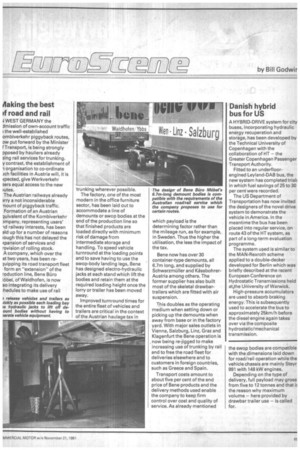ilaking the best d road and rail
Page 47

If you've noticed an error in this article please click here to report it so we can fix it.
.IWEST GERMANY the
Jrnission of own-account traffic ) the well-established ombiverkehr piggyback routes, ow put forward by the Minister f Transport, is being strongly pposed by hauliers already sing rail services for trunking. y contrast, the establishment of -iorganisation to co-ordinate c h facilities in Austria will, it is (pected, give Werkverkehr iers equal access to the new wtes.
The Austrian railways already irry a not inconsiderable
-nount of piggyback traffic. Formation of an Austrian quivalent of the Kombiverkehr mpany, representing users' ld railway interests, has been .91c1 up for a number of reasons lough this has not delayed the (pansion of services and -ovision of rolling stock.
A company, which over the St two years, has been reluipping its road transport fleet form an "extensionof the roduction line, Bene Biro label, of Waidhofen, is now so integrating its delivery :hedules to make use of rail
trunking wherever possible.
The factory, one of the most modern in the office furniture sector, has been laid out to accommodate a line of demounts or swop bodies at the end of the production line so that finished products are loaded directly with minimum risk of damage from intermediate storage and handling. To speed vehicle turnround at the loading points and to save having to use the swop-body landing legs, Bene has designed electro-hydraulic jacks at each stand which lift the bodies and retain them at the required loading height once the lorry or trailer has been moved away.
Improved turnround times for the entire fleet of vehicles and trailers are critical in the context of the Austrian haulage tax in which payload is the determining factor rather than the mileage run, as for example, in Sweden. Thus the higher the utilisation, the less the impact of the tax.
Bene now has over 30 container-type demounts, all 6.7m long, and supplied by Schwarzmuller and KassbohrerAustria among others. The former supplier has also built most of the skeletal drawbartrailers which are fitted with air suspension.
This doubles as the operating medium when setting down or picking up the demounts when away from base or in the factory yard. With major sales outlets in Vienna, Salzburg, Linz, Graz and Klagenfurt the Bene operation is now being re-jigged to make increasing use of trunking by rail and to free the road fleet for deliveries elsewhere and to customers in foreign countries, such as Greece and Spain.
Transport costs amount to about five per cent of the end price of Bene products and the delivery methods used enable the company to keep firm control over cost and quality of service. As already mentioned the swop bodies are compatible with the dimensions laid down for road/rail operation while the vehicle chassis are mainly Steyr 991 with 148 kW engines.
Depending on the type of delivery, full payload may gross from five to 12 tonnes and that the reason why maximum volume — here provided by drawbar trailer use — is called for.


















































